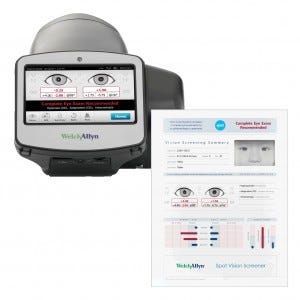Tips for Coordinating Spot Vision Screening Q & A
- Jun 4, 2018
- 0 Comments
 We received many questions during our Tips for Coordinating Spot Vision Screening webinar. As a resource for you, we have compiled the most frequently-asked questions and have provided them here with their answers.
We received many questions during our Tips for Coordinating Spot Vision Screening webinar. As a resource for you, we have compiled the most frequently-asked questions and have provided them here with their answers.If you have a question about the Spot Vision Screener and don't see an answer here, be sure to request a consultation with one of our vision screening experts!
Q: Do you still need to do a visual acuity test?
A: The Welch Allyn Spot Vision Screener uses a completely objective screening methodology to screen for 6 potential vision issues including amblyopic risk factors, common refractive errors, and strabismus. Visual Acuity testing is subjective but can identify visual problems unrelated to refractive error. Both screening methods have their benefits and limitations; therefore, the most thorough exam occurs when both instrument-based vision screening and visual acuity are used.
Q: Can I convert the results to a visual acuity score (20/20, 20/40)?
A: No. The Spot Vision Screener results will indicate “All Measurements in Range” or “Complete Eye Exam Recommended.” The device also lists the condition(s) found and the measurements of each eye. Welch Allyn does not recommend converting the results to a visual acuity score. If your state requires a visual acuity score we recommend using age appropriate tests and following state vision screening guidelines.
Q: How does it measure stereopticity?
A: It doesn’t. The Spot Vision screener is completely “objective” in that it requires no response. Whereas stereopsis is “subjective” (requiring a response from the subject). That would be a different test. If your state requires a Stereopsis screening we recommend using age appropriate tests and following state vision screening guidelines.
Q: Does the result screen delineate between near and distance results?
A: Spot Vision Screener can detect measurements for Myopia (near-sighted) and Hyperopia (far-sighted) which are what a near or distance vision test looks for. In addition, Spot detects 3 amblyopic risk factors (Hyperopia, Strabisus (Gaze) and Anisometropia (unequal refractive power) as well as Astigmatism (blurred vision) and Anisocoria (unequal pupil size).
Q: Can you screen children who are wearing glasses?
A: Yes, but it will take the glasses into consideration. Spot has criteria settings and if they are not referred then they met the criteria settings already established within the devices.
Q: Any suggestions on screening students who wear glasses?
A: Screening with glasses can be tricky, you can screen through single Rx Lens (no bifocals) with Spot. To screen students with glasses, push the glasses up the nose and drop the chin. This helps move the glare off the lens for a better capture. The thicker the lens, the more challenging it can be to screen through; this is also the case if the lenses have scratches on them. It is easiest to screen children wearing glasses in a dark room that minimizes reflections off the lenses.
Q: How accurate are the results? Sometimes if I screen the child two or three times I get both pass and refer.
A: It’s best to go with the first result while the eyes are in a natural relaxed state whereas continually screening the same patient can result in accommodation, thus skewing the results.
Q: Why do I get different results for the same student if I have trouble screening and try again?
A: Accommodation is the ability for the human eye to improve vision when provided time to focus on an object.This is most widely discussed with amblyopic risk screening on children under age 6 but can still occur with subjects over 6 years of age. This also may occur when a child is just below or above the criteria threshold for their age, thus prompting multiple results. As with the previous question, the best practice is to go with the first result.
Q: What is the recommended age for use?
A: Refer to the Welch Allyn statement regarding use of Spot Vision Screener in school-aged children.
Q: How reliable is this tool when screening children with developmental disabilities that have difficulty focusing on the machine?
A: Spot Vision Screener is an effective tool for screening children with developmental disabilities. Remember, Spot does not replace a comprehensive eye exam and children with disabilities may also need to see an eye doctor. Spot has an extremely high capture rate even with Autistic or developmentally delayed children. It’s vision optics system and design results in a high capture rate and the non-invasive screening distance of 3.3 feet helps allow the child to be comfortable without feeling like you’re invading their space.
Q: How do you load student data for screening?
A: There are three options available for loading student data for screening into the device.
- INSTANT SCREENING - Screen and then follow the prompts to enter the student’s information including name, ID, date of birth, gender, etc.
- SELECT FROM THE QUEUE - Preload a list of students by utilizing the import/export function which allows you to create a spreadsheet and load the data into the device by using a USB.
- PRE-ENTER STUDENT DATA - Follow the prompts to enter the student’s information including name, ID, date of birth, gender, etc., then proceed to the screening portion.
Q: Is financial assistance available to purchase a Spot?
A: You might reach out to a local Lions Club or other local charitable organization, like Prevent Blindness, for assistance; they have helped with the purchase of equipment. Some schools have utilized their Medicaid reimbursement funds to purchase the Spot Vision Screener. Others have utilized the banner space at the bottom of the results page to raise funds by promoting local services and/or optometrists.
